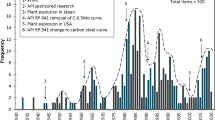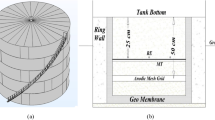The soil environment of an emergency section of a main gas pipeline is characterized as “near-neutral” (pH < 8) with middle or, in some cases, even high (more than 0.3 mm/year) corrosion activity and can be modeled by the NS4 solution. Long-term operation (23 years) decreases mainly the static crack resistance of X60 and X70 steels, whereas hydrogenation under the potential of cathodic protection sharply increases their susceptibility to stress corrosion fracture under both static and cyclic loading. The X70 steel is more sensitive to the negative influence of operation and hydrogenation as compared with X60 steel. We have evaluated the residual lifetime of the section of the “Urengoi–Pomary–Uzhgorod” main gas pipeline with regard for hydrogenation of the pipeline wall.


Similar content being viewed by others
References
V. V. Rozhonyuk, Pipeline Transport of Natural Gas [in Ukrainian], Kyi, Kyiv (2008).
S. Kornienko and O. Korbutyak, “Problems of the influence of soil environment on the corrosion of Ukrainian main gas pipelines,” Visnyk Kyiv. Nats. Univ., Ser. Heolohiya, 46, 42–43 (2009).
V. V. Panasyuk (editor), Fracture Mechanics and Strength of Materials: Handbook [in Ukrainian], Vol. 11: H. M. Nykyforchyn, S. H. Polyakov, V. A. Chervatyuk, et al., Strength and Durability of Oil and Gas Pipelines and Reservoirs, Spolom, Lviv (2009).
E. I. Kryzhanivs’kyi and H. M. Nykyforchyn, Corrosion-Hydrogen Degradation of Oil and Gas Pipelines and Its Prevention: Scientific and Technical Manual [in Ukrainian], Vol. 1: Foundations of the Evaluation of Pipeline Degradation, Ivano-Frankivs’k Nat. Techn. Univ. Oil Gas, Ivano-Frankivs’k (2011).
Standard Test Method for J -Integral Characterization of Fracture Toughness. ASTM. E 813, Annual Book of ASTM Standards, Vol. 03.01, 713–727.
RD-50-345-82. Methodical Instructions. Strength Analysis and Tests. Methods of Mechanical Tests of Metals. Determination of the Characteristics of Crack Resistance (Fracture Toughness) under Cyclic Loading [in Russian], Izd. Standartov, Moscow (1983).
W. Zheng, M. Elboujdaini, and R. W. Revie, “Stress corrosion cracking in pipelines,” in: V. S. Raja and T. Shoji (editors), Stress Corrosion Cracking. Theory and Practice, Woodhead, Cambridge (2011), pp. 749–771.
S. I. Hirnyi, “Anodic hydrogenation of iron in a carbonate-bicarbonate solution,” Fiz.-Khim. Mekh. Mater., 37, No. 3, 103–110 (2001); English translation: Mater. Sci., 37, No. 3, 491–498 (2001).
MR 185-86. Strength Analysis and Tests. Methods of Tests for the Susceptibility of Steels and Alloys to Corrosion Cracking in Liquid Media [in Russian], VNIINMASH, Moscow (1986).
O. T. Tsyrul’nyk, Z. V. Slobodyan, O. I. Zvirko, et al., “Influence of operation of Х52 steel on corrosion processes in a model solution of gas condensate,” Fiz.-Khim. Mekh. Mater., 44, No. 5, 88–99 (2008); English translation: Mater. Sci., 44, No. 5, 619–629 (2008).
O. V. Hembara and O. E. Andreikiv, “Effect of hydrogenation of walls of oil and gas pipelines on their soil corrosion and durability,” Fiz.-Khim. Mekh. Mater., 47, No. 5, 27–34 (2011).
A. O. Sakara and Yu. V. Banakhevych, “A computation model of the subcritical growth of stress-corrosion cracks in metallic plates,” Fiz.-Khim. Mekh. Mater., 46, No. 3, 23–29 (2010): English translation: Mater. Sci., 46, No. 3, 307–314 (2010).
A. E. Andreikiv and A. I. Darchuk, Fatigue Fracture and Durability of Structures [in Russian], Naukova Dumka, Kiev (1992).
Author information
Authors and Affiliations
Corresponding author
Additional information
Translated from Fizyko-Khimichna Mekhanika Materialiv, Vol. 48, No. 2, pp. 103–110, March–April, 2012.
Rights and permissions
About this article
Cite this article
Andreikiv, O.E., Hembara, O.V., Tsyrul’nyk, O.T. et al. Evaluation of the residual lifetime of a section of a main gas pipeline after long-term operation. Mater Sci 48, 231–238 (2012). https://doi.org/10.1007/s11003-012-9497-7
Received:
Published:
Issue Date:
DOI: https://doi.org/10.1007/s11003-012-9497-7




